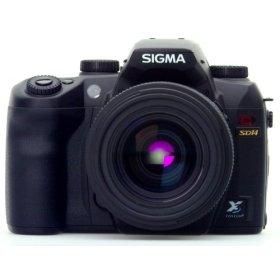: Sigma SD14 14MP Digital SLR Camera (Body Only)
Categoría: Compra - Venta
Subcategoría: Electrónica
Subcategoría: Electrónica
Precio:
Llame para el precio
- o -
Contactar al proveedor
he new SD14, powered by the 14-megapixel Foveon X3 direct-image sensor, can reproduce high definition images rich in gradation and impressive three-dimensional detail. The SD14 digital SLR camera features four JPEG recording modes, a large and bright pentaprism viewfinder with 98% coverage, a built-in flash with a Guide Number of 11, 5-point AF system, a large 2.5-inch, 150,000-pixel resolution LCD monitor, as well as a new user-friendly design. The durable shutter mechanism has over 100,000-cycle life and is ideal for the demands of digital photography.Development
Sigma introduced its first digital SLR camera, the SD9, to the market in October 2002, and has established strong support from a wide range of photographers both amateur and professional alike. The second model, the SD10, released on to the market in November 2003, continued to build on the support of loyal photographers. However, demand for JPEG's greater convenience in image handling has increased and in order to meet this demand the new SD14, powered by Foveon X3 direct-image sensor, now includes JPEG mode with high image quality, high performance, and versatility.Product Summary
The Sigma SD14's Foveon sensor captures full and complete color with three sensor layers.14-megapixel Foveon X3 direct image sensor
The Foveon X3 direct image sensor featured in the Sigma SD14 digital SLR can capture all primary RGB colors at each and every pixel arranged in three layers, insuring the capture of full and complete color. Using three silicon-embedded layers of photo detectors, stacked to take advantage of silicon's ability to absorb red, green, and blue light at different respective depths, it efficiently reproduces color more accurately and offers sharper resolution pixel for pixel than any conventional image sensor.
Until now, all other image sensors have featured a just single layer of pixels and each pixel captures only one color of light, which has been filtered through a single color filter. Since mosaic-based conventional image sensors capture only one-third of the color, complicated computations are required to interpolate the colors they miss. Interpolation leads to color errors, color artifacts, and a loss of image detail. Low-pass filters must then be used to reduce color artifacts. The use of low-pass filters adversely affect sharpness and resolution of the final image captured.
Sigma introduced its first digital SLR camera, the SD9, to the market in October 2002, and has established strong support from a wide range of photographers both amateur and professional alike. The second model, the SD10, released on to the market in November 2003, continued to build on the support of loyal photographers. However, demand for JPEG's greater convenience in image handling has increased and in order to meet this demand the new SD14, powered by Foveon X3 direct-image sensor, now includes JPEG mode with high image quality, high performance, and versatility.Product Summary
The Sigma SD14's Foveon sensor captures full and complete color with three sensor layers.14-megapixel Foveon X3 direct image sensor
The Foveon X3 direct image sensor featured in the Sigma SD14 digital SLR can capture all primary RGB colors at each and every pixel arranged in three layers, insuring the capture of full and complete color. Using three silicon-embedded layers of photo detectors, stacked to take advantage of silicon's ability to absorb red, green, and blue light at different respective depths, it efficiently reproduces color more accurately and offers sharper resolution pixel for pixel than any conventional image sensor.
Until now, all other image sensors have featured a just single layer of pixels and each pixel captures only one color of light, which has been filtered through a single color filter. Since mosaic-based conventional image sensors capture only one-third of the color, complicated computations are required to interpolate the colors they miss. Interpolation leads to color errors, color artifacts, and a loss of image detail. Low-pass filters must then be used to reduce color artifacts. The use of low-pass filters adversely affect sharpness and resolution of the final image captured.










